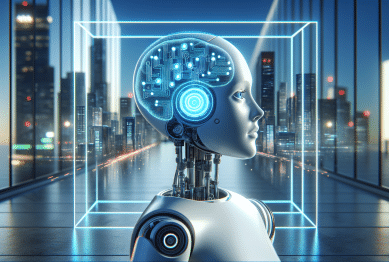With artificial intelligence everywhere, many wonder if its decisions can be trusted. This article unpacks AI systems, explains how machine learning impacts reliability, and explores transparency issues in technology you use daily.
Understanding Artificial Intelligence and Its Decision-Making
Artificial intelligence is changing the way decisions are made in countless areas. From banking and medical diagnostics to voice assistants and facial recognition, AI quietly shapes many facets of life. These intelligent systems process huge volumes of data and learn patterns so they can suggest actions or draw conclusions. But what actually happens behind AI’s black box? Most often, AI relies on sophisticated machine learning algorithms. These algorithms analyze past experiences (data), updating their predictions over time. The goal is to spot trends, flag risk, or make recommendations more efficiently than any human could. However, understanding what leads to an AI decision remains complex. The specific values, weights, or neural patterns that guide choices are not always visible to users or even programmers. This opacity has led to growing calls for transparency and ethical oversight in artificial intelligence applications (https://plato.stanford.edu/entries/ethics-ai/).
Many people assume artificial intelligence is perfectly objective. The reality is more nuanced. Biased or incomplete training data can introduce unintentional errors. If an AI system is trained primarily on certain populations, for example, its recommendations might unfairly favor those groups. Even with robust data, AI can sometimes misinterpret rare, unexpected, or contradictory information. This means it is important to review not only results but also the data sources themselves. Initiatives within the AI community are seeking ways to improve dataset diversity and fairness, but there is no universal standard yet for verifying data quality or outcomes for every possible application (https://www.nist.gov/artificial-intelligence).
Where does machine intelligence outperform human logic? In repetitive tasks, pattern recognition, and high-speed calculations, AI often exceeds expected results with greater consistency. Yet, artificial intelligence may lack the intuitive judgment humans bring—especially in ambiguous or highly sensitive contexts. For example, in medical imaging, machine learning can detect tumors that are difficult for specialists to see, but it’s less adept at considering lifestyle and personal context in treatment plans. The interplay between AI accuracy, explainability, and context-aware judgment remains a central challenge as these systems become more deeply woven into daily technology and critical infrastructure (https://healthit.gov/topic/scientific-initiatives/precision-medicine/artificial-intelligence-healthcare).
The Role of Data in AI System Reliability
Data is the foundation of every artificial intelligence engine. Large datasets fuel everything from picture recognition to language models, and their quality dictates system trustworthiness. Clean, comprehensive data allows AI to learn accurate representations and make fair decisions. However, if datasets are skewed by missing information or overrepresented patterns, AIs risk replicating those flaws on a massive scale. That’s why organizations are increasingly auditing training datasets for bias, diversity, and completeness before using them in real-world applications (https://www.nist.gov/news-events/news/2022/03/nist-seeks-comments-ai-risk-management-framework-concept-paper).
One common concern is that machine learning can amplify errors embedded in its training material. If a predictive policing tool is fed historical records skewed by past prejudice, it uncovers and repeats those issues in modern decisions. In other industries, reliance on incomplete or outdated datasets could result in overlooked opportunities or systemic risk. Regularly updating and monitoring data inputs safeguards against entrenched mistakes, helping artificial intelligence models adapt to changing realities over time. Many experts recommend regular model retraining and human-in-the-loop review to keep data integrity high and system recommendations sound.
What happens when new information challenges established patterns? Continuous learning is the ability for an AI system to update its knowledge as new data arrives. This dynamic approach is particularly valuable where trends shift rapidly, such as financial forecasting or medical research. However, dynamic models can sometimes overfit recent events, leading to sudden changes in predictions or inconsistent decisions. To guard against these issues, many organizations rely on hybrid solutions: blending machine-driven analysis with human oversight, ensuring AI insights remain grounded in updated, robust data sources (https://www.brookings.edu/articles/how-humans-can-keep-control-of-artificial-intelligence/).
Transparency and Explainability in Artificial Intelligence
Despite rapid progress in machine learning, many artificial intelligence models are described as “black boxes.” Users see predictions or recommendations but cannot tell how those outcomes were reached. This lack of transparency erodes trust, especially in contexts where fairness, accountability, or regulatory compliance are essential. As more industries rely on AI—from hiring to healthcare—demands have grown for explainable AI (XAI). Explainable AI seeks to reveal the factors guiding each decision, providing a window into the values, priorities, or risk factors at play. Ongoing research into model interpretability is helping users assess results with greater confidence (https://www.nist.gov/challenges/ai-explainability).
How do explainable artificial intelligence systems work? Some leverage visualization tools, highlighting important variables or mapping influential connections. Others summarize decision pathways in plain language, making them accessible to individuals without technical expertise. A particularly important development is local interpretability, where users ask the AI to explain just one outcome—like why a mortgage application was denied—instead of the full model logic. Emerging standards and guidelines help developers create and test models that make transparent, defensible decisions. However, explainability often comes with technical trade-offs: more interpretable models can be slightly less powerful than opaque, deep-learning neural networks.
Can all artificial intelligence systems be made truly transparent? The answer depends on the complexity and purpose. Rule-based or decision tree models are relatively easy to audit, but deep learning networks with millions of parameters remain challenging to decode fully. Even so, regulatory bodies, advocacy groups, and tech leaders increasingly agree: end-users deserve to understand the basis for high-impact automated decisions, especially those affecting finance, employment, or health. Progress in this area is ongoing, with international collaborations developing open benchmarks for explainability, interpretability, and algorithmic accountability (https://hls.harvard.edu/experts-guides/artificial-intelligence-and-the-law/).
Bias and Ethics in Machine Learning Algorithms
Artificial intelligence systems do not operate in a vacuum; they inherit assumptions, social dynamics, and values from their training data and design teams. Even well-intentioned technologists can inadvertently introduce bias if issues in data or modeling are left unchecked. For instance, language models reflecting stereotypes or hiring AIs reinforcing legacy discrimination are all-too-common risks. The challenge is not just technical—it’s also deeply ethical. Ensuring algorithmic fairness requires interdisciplinary evaluation, including diverse teams and systematic audits (https://www.aaas.org/resources/spotlight/algorithmic-bias).
What does responsible machine learning look like? Leading organizations adopt bias detection, remediation, and documentation at every stage of the system’s life cycle—from data collection to software deployment. This means running tests on representative datasets, simulating edge cases, and providing clear communication about model strengths and limitations. Regulatory frameworks from the EU and US are being developed, requiring transparency, bias mitigation, and independent assessments for high-stakes AI uses. Ongoing collaboration between technologists, ethicists, and policy makers ensures that artificial intelligence integrates with broader legal and social frameworks.
Can artificial intelligence ever be fully free from human values? While no system can be perfectly unbiased, rigorous design can minimize the risks. Openly discussing limitations, sharing model details with impacted communities, and constantly monitoring deployed systems all improve trustworthiness. Developers are increasingly urged to adopt ethical AI principles such as fairness, accountability, transparency, and inclusivity. By foregrounding these priorities, future applications can better reflect and serve the diverse societies that use them.
Human Oversight in the Age of Automation
Automation enables artificial intelligence to handle massive datasets and complex calculations, often with little or no manual intervention. Yet, the idea that AI can—or should—operate without human guidance is being questioned. In practice, the best outcomes often emerge when human expertise and machine speed are combined. For example, AI may identify patterns in satellite imagery more quickly, but analysts must validate findings and adapt strategies as global events unfold. Human-in-the-loop approaches help ensure automated decisions remain grounded and accountable.
Industries such as medicine, law, and finance illustrate the importance of complementing AI insights with human expertise. In diagnostic imaging, an artificial intelligence system can highlight probable areas of concern, but a physician reviews the analysis, weighing patient history and clinical context. In banking, AIs spot potential fraud, but experienced professionals make the final call before important transactions are stopped. This partnership allows for blending scalability with nuance, balancing statistical probability with ethical, contextual, and situational judgment (https://www.fda.gov/medical-devices/software-medical-device-samd/artificial-intelligence-and-machine-learning-software-medical-device).
What does the future hold for oversight and collaboration? As artificial intelligence agents become more capable, new strategies are emerging for shared control: dynamic thresholds, user override options, and explainable feedback loops all help keep decision-making transparent and aligned with human values. Strategies like these make AI more trustworthy and integrated, reducing risk without hampering innovation. The focus is shifting from replacing humans with automation to strengthening and empowering people through thoughtful collaboration with intelligent machines.
Building Trust in Artificial Intelligence for Everyday Users
How can the average person feel confident about AI-driven processes? Understanding the data sources, system design, and limitations of artificial intelligence solutions is a start. Transparent labeling, plain-language explanations, and accessible support channels all support informed decision-making. Major technology providers are developing resources to help users see how recommendations are generated, fostering greater trust in digital tools and services. Consumer awareness also drives platform accountability, encouraging ongoing improvement based on feedback and changing societal norms (https://consumer.ftc.gov/articles/what-know-about-artificial-intelligence-and-consumer-products).
Where should individuals turn for guidance or to resolve AI-related issues? Many regulators and advocacy organizations now offer channels for reporting suspected errors, bias, or misuse of automated systems. This oversight encourages responsible design, continuous monitoring, and swift remediation when needed. As user communities grow, peer reviews and crowd-sourced knowledge are becoming essential tools for identifying and correcting risks before they escalate. Learning to recognize how AI systems function and how decisions are made equips consumers to ask smart questions and safeguard their interests.
Trust is an ongoing process, not a fixed destination. As technology changes, so do the possibilities and pitfalls. By staying informed and actively participating in discussions around artificial intelligence, users play a critical role in shaping the ethical and practical evolution of these powerful tools. Collaboration among developers, policymakers, and everyday users ensures that artificial intelligence can continue improving lives while remaining safe and reliable for all.
References
1. Stanford University. (n.d.). Ethics of Artificial Intelligence and Robotics. Retrieved from https://plato.stanford.edu/entries/ethics-ai/
2. National Institute of Standards and Technology. (n.d.). Artificial Intelligence. Retrieved from https://www.nist.gov/artificial-intelligence
3. HealthIT.gov. (n.d.). Artificial Intelligence in Healthcare. Retrieved from https://healthit.gov/topic/scientific-initiatives/precision-medicine/artificial-intelligence-healthcare
4. Brookings Institution. (2022). How humans can keep control of artificial intelligence. Retrieved from https://www.brookings.edu/articles/how-humans-can-keep-control-of-artificial-intelligence/
5. Harvard Law School. (n.d.). Artificial Intelligence and the Law. Retrieved from https://hls.harvard.edu/experts-guides/artificial-intelligence-and-the-law/
6. Federal Trade Commission. (n.d.). What to Know About Artificial Intelligence and Consumer Products. Retrieved from https://consumer.ftc.gov/articles/what-know-about-artificial-intelligence-and-consumer-products









